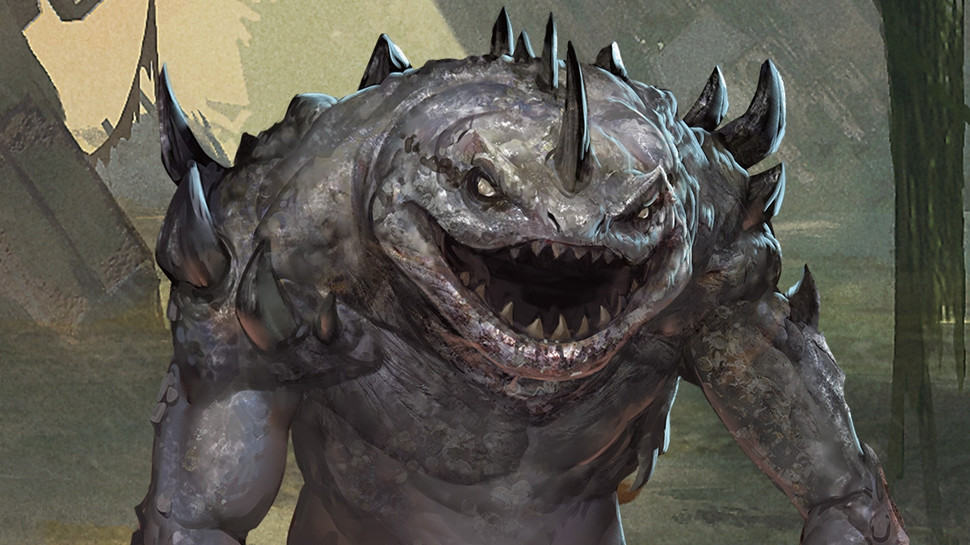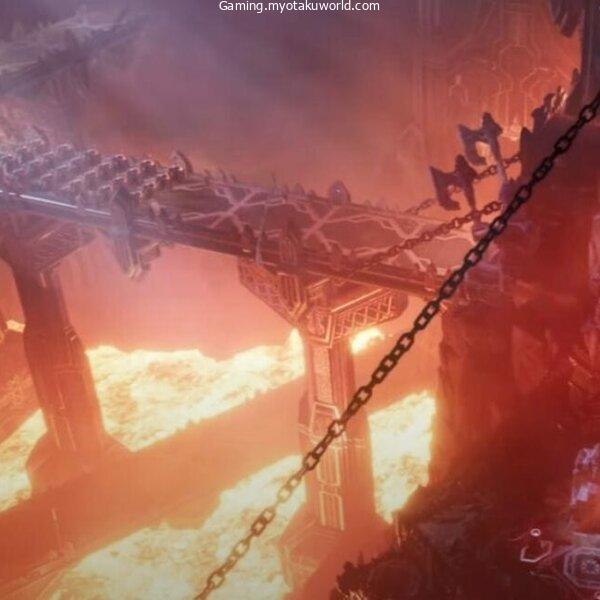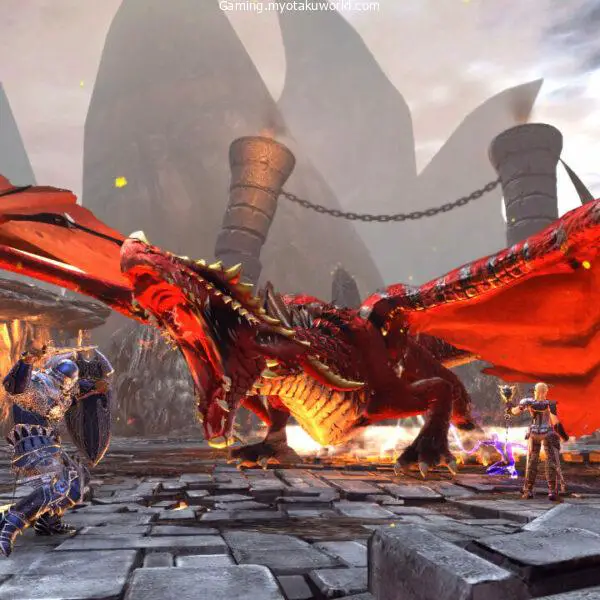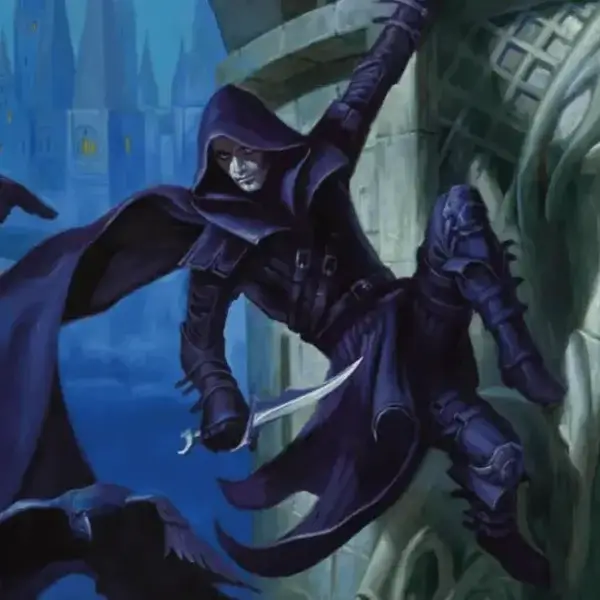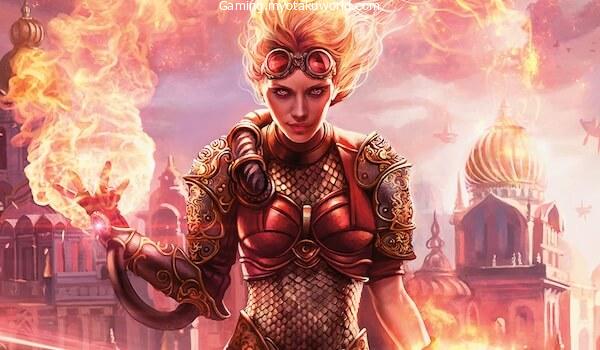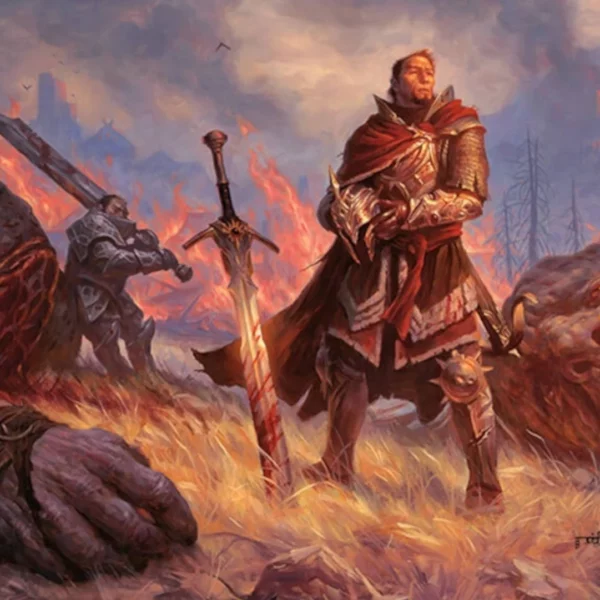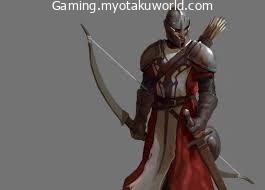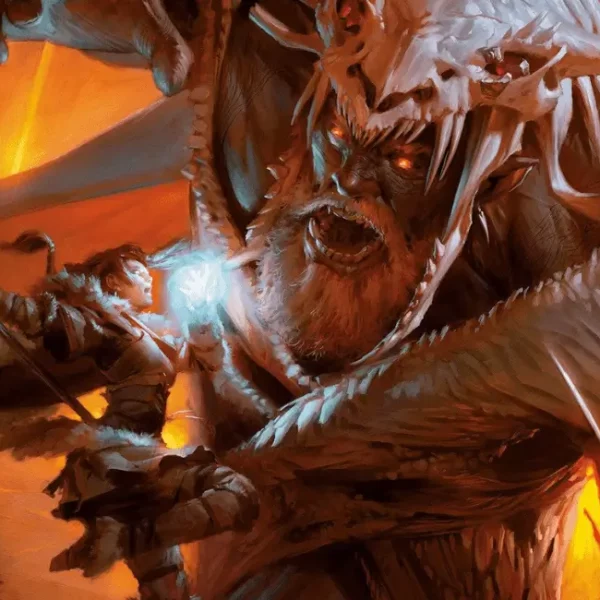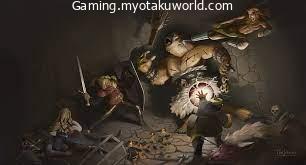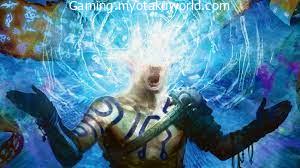In many fantasy settings and stories, giants are a common feature. So it shouldn’t come as a surprise that Dungeons & Dragons uses them in their settings.
But in 5th Edition D&D, what are giants?
In this post, I’ll talk about what giants are in D&D 5e, how to use them in your game, and some common questions about the creature type.
First, let’s take a look at what 5e giants are.
One type of creature in D&D 5e is a giant. It includes big, vaguely human-like creatures, some of which are connected to magical energies.
Most of the time, giant-type creatures are:
- Bigger than average humanoids
- Stronger in the body than many other creatures,
- In some ways, they look like us.
On page 7 of the Monster Manual, giants are called:
“Giants tower over humans and their kind. They are humanlike in shape, though some have multiple heads (ettins) or deformities (fomorians). The six varieties of true giant are hill giants, stone giants, frost giants, fire giants, cloud giants, and storm giants. Besides these, creatures such as ogres and trolls are giants.”
The one thing that all 5e giant creatures have in common is that they are big. Aside from that, they are all different.
Some have ties to the elements, some can use magic, and some are mostly martial fighters.
Most 5e giants, though, look like humans in some way. This means that most giants walk on two legs and have human-like faces and bodies.
Still, there is room for difference. For example, a troll’s arms are usually longer than those of a normal humanoid.
And the skin tones of many 5e giants are different from those of most humanoids (like blues, reds, or greys).
There are two kinds of creatures of the giant creature type: true giants and creatures that look like giants.
This isn’t an official name, though. But it helps to tell the difference between giants and creatures of the giant type. Similar to how the dragon creature type in 5e works.
Let’s start with the biggest ones and work our way down.
True Giants in D&D 5e

In 5e, there are true giants, which are like dragons in D&D. When you hear the word “giant” in D&D, you probably think of these. These are big creatures that look like people and have magical powers.
When you think of a “giant,” you probably think of a real one. All of them look a little bit like people, even more so than many of the giant-kin, and they are large or incredibly large in size.
For some reason, a lot of people, including myself, think that giants like to throw big rocks at things. However, this is not true.
Now, just like dragons, there are many different kinds of real giants. But, unlike our scaly friends, true giants don’t come in as many different kinds.
In 5e, there are six types of true giants:
- Cloud Giant
- Fire Giant
- Frost Giant
- Hill Giant
- Stone Giant
- Storm Giant
If you use the history of the Forgotten Realms, there is a whole thing about the Ordning and a giant’s place among his own kind. But I won’t talk about that. In essence, it is a huge caste system.
So much for the introduction. Let’s go over the real giants in alphabetical order.
Cloud Giants
Cloud giants live in the clouds, which are very high up in the sky. They’re some of the most haughty real giants because they tend to think they’re the best of the best.
Cloud giants live at the tops of the world, as their name suggests. Some of them even live on top of solid clouds way up in the sky.
If you look at the Cloud giants in the Monster Manual, you’ll see that their status is tied to how much money they have. So, a Cloud giant’s rank among giants goes up the more treasures he or she has.
Cloud giants often use other giants to get what they want, which is to get rich. Fire giants could be used as blacksmiths, Frost giants as raiders, and Hill giants as brutes.
Still, Cloud giants aren’t easy to beat. In the Monster Manual, they are the second strongest true giants after Storm giants.
These giants can already do some spells on their own. Something that most of the other true giants from the ground can’t do.
Most of the time, cloud giants are the second tallest of the real giants.
Fire Giants
In D&D 5e, fire giants are very good at smithing, making things, and making art. They are also some of the most disciplined warriors among giants.
Most of the time, these giants claim the land around active volcanoes, in hot deserts, and even on the Plane of Fire.
Fire giants have a bad reputation as cruel soldiers and conquerors because of how they learned to fight. From a young age, they train and learn the rules of war.
Fire giants are the best crafters and artists among the true giants, even though they have a reputation for being violent. They melt metal, forge it, and make great weapons, armor, and siege weapons out of it.
When compared to other true giants, fire giants are pretty short. In fact, they are the second-shortest of their kind. Most of the time, they only stand taller than hill giants.
Hill Giants
The hill giants are the weakest giants. They aren’t as smart as most other giants, and all they want to do is eat.
That doesn’t mean that Hill giants always have to eat. They just don’t know what else to do. That I can understand. Also, it seems like they can eat almost anything. Which is a fun note for any DMs who are reading this.
Hill giants show that they are the best at what they do by being the biggest and strongest of their kind. They don’t know much and don’t have many skills. So, the only way they can stand out is by being very strong.
The next thing that makes the Hill giants unique is that they are not smart. True giants don’t usually have high IQ scores. Hill giants, on the other hand, tend to have this as their worst stat by a long shot.
Hill giants are the shortest of the real giants.
Stone Giants
Stone giants are one of the most unusual real giants. They are strong but graceful, and they put a lot of value on art.
Most of the time, these giants live in the ground. Stone giants live deep underground. Other true giants live on the surface, either in the Mortal Realm or on one of the Elemental Planes. Still, they could live somewhere on the Elemental Plane of Earth, depending on how you see it.
Stone giants are built for sports. They try to be both strong and graceful when they play sports.
While strength and grace are important, Stone giants place the most value in artistry. Stone giants paint and carve stones, while Fire giants say they are the best at making things.
Using the legends of the Forgotten Realms’ Stone giants, the surface world is like a dream to them. So, when they are not in their underground homes, they tend to act in strange ways. They’re not in a dream, that’s clear. So, I’d throw that piece of folklore out right away.
Stone giants are the third-shortest of the real giants. Most of the time, they are about the same height as a Fire giant or a Frost giant.
Storm Giants
In the Monster Manual, storm giants are the strongest of the true giants. They live alone and don’t often talk to their own kind, let alone the rest of the world.
Storm giants live in tall places around the world, just like Cloud giants. Storm giants love to live in mountain peaks that rise above the clouds and castles that fly through the air. Still, they might also build a home deep in the ocean.
Storm giants live in the wilderness, far from other people. They don’t often talk to other animals. So, it’s a big deal to meet a Storm giant.
These creatures watch and can see. They watch the rise and fall of civilizations and try to find signs in every part of history as it happens.
Like Cloud giants, Storm giants can use some spells that are built into them. And, in terms of Ability Scores, they are the strongest of the real giants (except in Dexterity, which goes to the Stone giants).
The Storm giants are the tallest and strongest of the true giants.
Giant-Kin in D&D 5e

In 5e, giant-kin are monsters that have the giant monster type but aren’t real giants.
Many of the rules that giants follow also apply to these creatures. They usually look like people, but there are some exceptions, like the two-headed ettins and the more monster-like trolls (not to mention the whole regenerating thing). And, most of them are Large or Huge, which are the same sizes as other clothes.
The good thing about giant-kin is that they tend to be more different from each other than giants themselves.
True giants follow similar paths, even if their cultures and maybe their numbers are different. Giant-kin, on the other hand, is very different.
For example, trolls are a common type of monster in many fantasy stories. Most of the time, they can also heal themselves or are weak to fire (as they do in D&D).
But the oni is an ogre with blue skin that can use magic. Both are giant monsters, but their stats and stories are very different.
Using Giants in Your D&D Game
In D&D 5e, giants can be used in many different ways, just like any other monster.
Using Giants as Antagonists
Giants, who are really big, make great bad guys and antagonists. Most of the time, they are smarter than the other big creatures, so they can plot and plan and have goals that hurt other creatures.
Still, some giant-kin, like the oni or ettin, can also be good arc villains, or even the endgame villain of your game.
In 5e, even low-level player characters are usually stronger than most giants. So, using giants as the bad guys is a great idea because it forces your party to grow and get stronger before they can face them.
Also, many of D&D’s giants (at least the ones in the Monster Manual) want money, power, or prestige. All classic reasons for a bad guy to do bad things.
Now, not every giant-kin will have the same goals as the others.
The only thing that drives trolls, ogres, cyclops, and even Hill giants is the need to stay alive. Most of the time, they won’t want to do anything more than maybe make a certain road, hill, or town miserable.
So, they work well as low-level or arc-based bad guys. But they’re not clever or ambitious enough to be the bad guys in a full-length game.
Still, I always tell you to break out of the mold and make these creatures unique. Give them goals or powers that are not typical of their kind.
Some examples of how giant creatures can be used as bad guys are:
- An ambitious fire giant seeks to conquer a vast desert.
- A cloud giant takes over the tallest mountain in an area and starts attacking the towns nearby.
- A Frost giant leader gathers more and more giants and moves across the north.
- The leader of the ettin bandits in a certain area has a tight grip on the trade routes.
- An oni causes nightmares and kidnappings in many of the towns nearby.
Using Giants as Ancillary Enemies

I wouldn’t use true giants as side enemies or random encounters, except for giants and the other giant-kin.
True giants are better as main threats or bad guys in your game. But giant-kin make great servants and people you meet by chance.
If someone or something from another world uses a giant as an assistant or foot soldier, they must be strong.
Even giants who are related to giants tend to be stubborn. So, giants are either used by smart or very strong creatures.
But if your players are going up against a giant bad guy, it makes sense to use the different giants as foot soldiers.
Giants can be used as secondary enemies or as random encounters.
- A troll and three satyrs fight over how much a bridge should cost to cross.
- A hungry hill giant runs through the forest after a scared centaur child.
- An oni uses ogres as a group of dangerous thieves who attack people on the road.
- An ogre sits on the edge of a ravine and blocks the only bridge that crosses the gap.
- A Frost Giant and a Hill Giant are used by a Cloud Giant to attack a town.
Using Giants as Allies
Giants are great allies in D&D, just like they are great bad guys. Friendly merchants, reluctant allies, and respectable scholars are all very strange ways to bring giants into your game as possible allies. The trick is to not overshadow small parties with the power of a giant.
Like any other half-smart creature in Dungeons & Dragons, giants can be used for more than just fighting. Depending on how you show them, giants could be friendly and willing allies, like merchants, or they could be reluctant allies, like exiled giants who would rather get revenge than attack the party.
I usually don’t care about things like alignment at this point. If you look at the stat blocks of a lot of big monsters, you’ll see that they are evil.
You can choose to follow them, and it might still work (for example, if an exiled giant is willing to help the party). But it’s more fun to have a Fire or Frost giant who is friendly or at least neutral and talks to your player characters.
Also, wouldn’t it be cool to have a giant friend?
You could maybe ask a giant clan to help you fight off an invasion of demons. Or, a giant who lives alone hires the group to find a piece of art that was thought to have been lost forever. As always, make it weird.
Some ways that D&D giants can be used as allies are:
- In exchange for a favor, an outcast fire giant will make a magical weapon for the party.
- An ettin mage and merchant on the road sells magical goods and gives information.
- A Frost giant who was sent away is willing to help the party as a way to get even.
- A troll helps people get through the land of the fey.
- A kind of storm giant gives the group a job to do in exchange for information.
5e Giants by CR
Here is a list of D&D 5e giants by their Challenge Rating. I only included those that are in the Basic Rules so that you can find them easily.
Check out DnD Beyond’s Monsters page for a full list of 5e giants sorted by CR.
CR 2 Giants in 5e
- Ogre
CR 4 Giants in 5e
- Ettin
CR 5 Giants in 5e
- Hill Giant
- Troll
CR 6 Giants in 5e
- Cyclops
CR 7 Giants in 5e
- Oni
- Stone Giant
CR 8 Giants in 5e
- Frost Giant
CR 9 Giants in 5e
- Cloud Giant
- Fire Giant
CR 13 Giants in 5e
- Storm Giant
FAQs
What is the Strongest Giant in D&D 5e?
Based on its Challenge Rating, Borborygmos from Guildmaster’s Guide to Ravnica is the strongest giant in D&D 5e. But the Storm Giant (Monster Manual) and the Storm Giant Quintessent (Volo’s Guide to Monsters), both of which have a Strength score of 29, are the strongest giants in 5e.
Are Giants Mortal in 5e?
Giants are mortal in 5e. Still, depending on what kind of giant they are, they live much longer than other people.
How Big Are Giants in 5e?
The size of most giants in 5e is Large or Huge. So, they are usually anywhere from 15 to 30 feet tall. In Storm King’s Thunder, the Cloud Giant Child is a medium-sized giant. So, there you go.
What Language Do Giants Speak in 5e?
In 5e, giants speak a language called “giant.”Which seems like a joke. But that’s the end of the story. The name of the language is “giant.”Still, some of the giant-kin can also speak Common.
Final Words
In D&D 5e, that’s about it for giants.
One of the 14 types of monsters in the game is the giant. They are also similar in that they are usually bigger than medium-sized animals and much stronger than other animals.
There are also two types of giants: true giants and giant-kin. The first one has your typical giants with specific themes, and the second one has trolls, cyclops, and ettins, which look like giants.
One last thing about giants in 5e: they are often part of the history of a world.
True giants are usually very old beings who fought and changed the world long before most humanoid races appeared. So, they have a deep and rich history that you can add to the history of your world.
Even so, it’s not uncommon for giants to come from other worlds. Fire giants might come from the Elemental Plane of Fire, and your trolls might come from the Fairy Realm. You can change D&D monsters to fit your game, just like you can change most monsters.
I’m going to do something a little different: I’m going to challenge you. Try adding a friendly (or neutral) giant to your game.
It’s up to you how you want to do that. But if you do, come back and tell me in the comments how it went. I would love to see what you come up with.
